Whether you’re a beginner or an advertising pro, there are many Facebook Ad mistakes you can make when creating or managing your campaigns. The key is to know which of these mistakes may be hurting your performance and how to resolve them as quickly as possible.
So in this blog post, we’re breaking down the most common Facebook ad mistakes and how to successfully avoid them. Let’s dive in!
Facebook Ad Mistake 1: Using the wrong campaign objective
When creating a Facebook Ad campaign, you’ll always need to start by choosing the right campaign objective.
The campaign objective essentially refers to your business goal, meaning what you’d like to achieve by advertising on Facebook. Are you looking to increase sales, or maybe collect leads for your next webinar?
You’ll notice that Facebook breaks down 3 main categories for you, each with different campaign objectives to choose from.
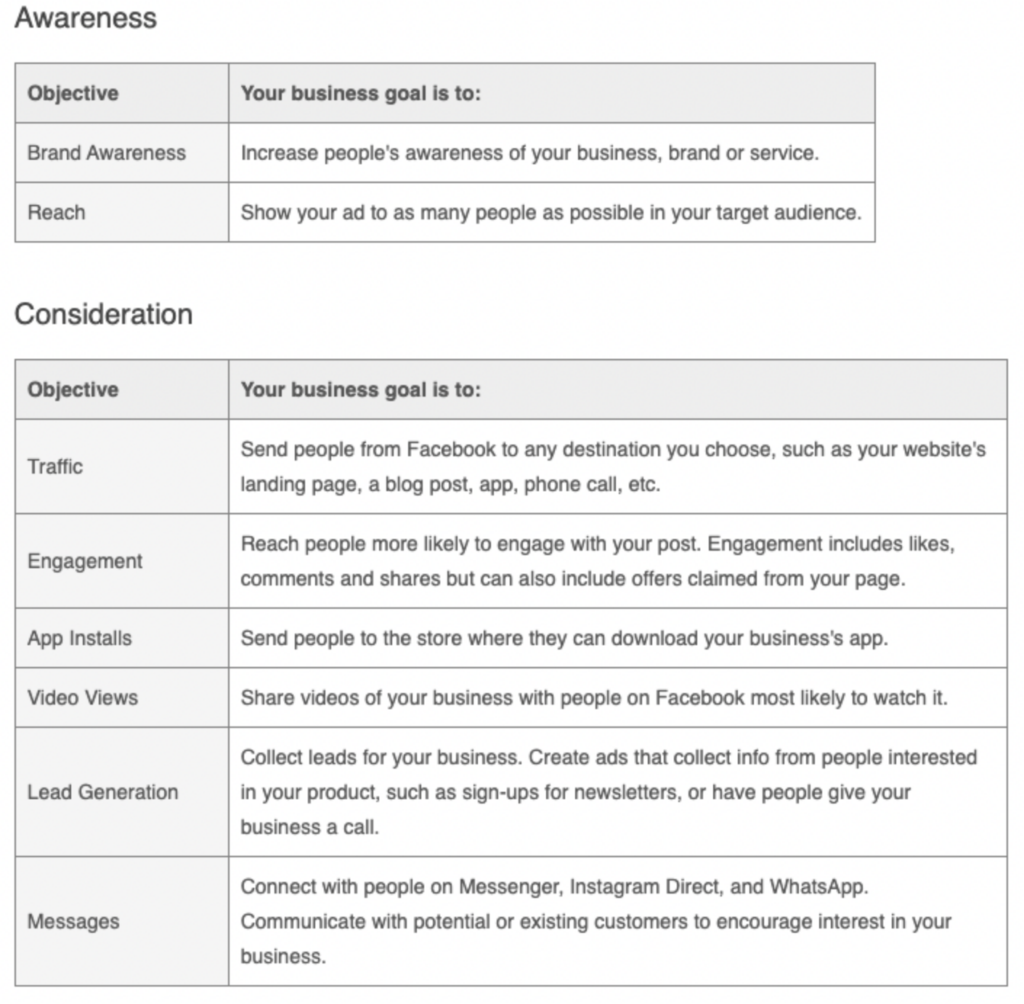
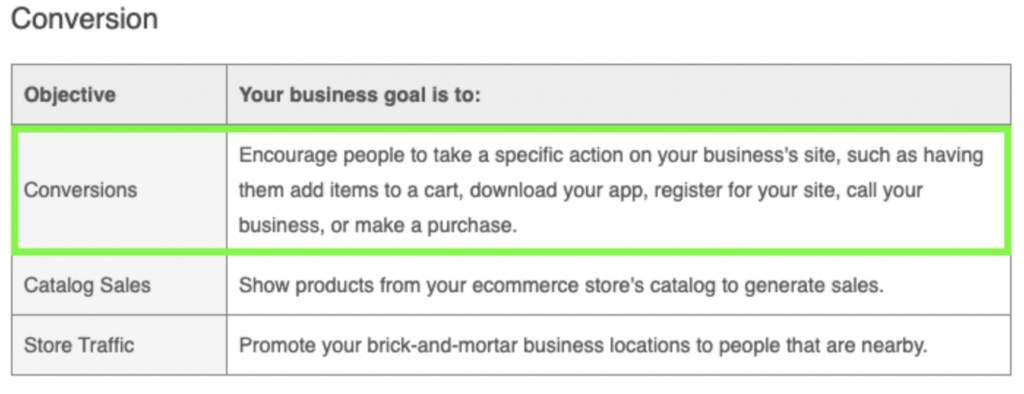
When creating a Facebook Ad campaign, you should always optimize for conversions as you ultimately want people to convert (purchase) on your website.
We often see advertisers choosing the Traffic objective over Conversions, but here’s why we don’t recommend doing so.
Choosing Traffic over Conversions would only result in Facebook finding you a lower-quality audience that is just going to browse through your website, but not necessarily convert. Generally, with Facebook Ads, you always get what you ask for.
So by optimizing for Traffic, Facebook is only going to focus on driving “cheap” traffic to your website, instead of finding users that are most likely to convert.
The bottom line is that you should always choose the campaign objective according to the action you want people to take after they see your ads.
g elit. Ut elit tellus, luctus nec ullamcorper mattis, pulvinar dapibus leo.
Facebook Ad Mistake 2: Using the wrong conversion event
Using the wrong Facebook Ad conversion event can massively impact the success of your campaigns.
When optimizing your campaigns for conversions, you also need to tell Facebook which type of conversion event to optimize your campaigns for.
A lot of advertisers think the best conversion event to choose would be the one that occurs more frequently, such as “Add To Cart” or “Initiate Checkout”.
But why is this wrong?
When you set “Add To Cart” as your conversion event, Facebook focuses on finding a subset of people who are most likely to complete that step – add an item to the cart.
While you may get a lot more conversion actions when optimizing for this conversion event, you’re less likely to get a higher-quality audience and generate more purchases.
So if your goal is to find users who will complete the last step in your funnel and purchase, you should always set “Purchase” as your conversion event.
Facebook Ad Mistake 3: Using the wrong ad set optimization
Another common Facebook Ad mistake we see a lot of advertisers make is choosing the wrong ad set optimization.
After setting your campaign objective and conversion event, you mustn’t forget about your ad set optimization. The ad set optimization that you choose will affect who sees your ads, and generally, how Facebook optimizes your ads.
So for example, if you choose to optimize for link clicks, Facebook will show your ad to people that are most likely to click on your ad.
On the flip side, if you optimize for conversions, Facebook will show your ads to people most likely to convert (purchase).
So always make sure to match the ad delivery/ad set optimization to your campaign objective.
Facebook Ad Mistake 4: Poor targeting
Ever been recommended to stack multiple lookalikes and interests into one ad set?
Well, we hope not, and here’s why.
First of all, the more you narrow your Facebook ad targeting, the higher the advertising price (CPM) is going to be.
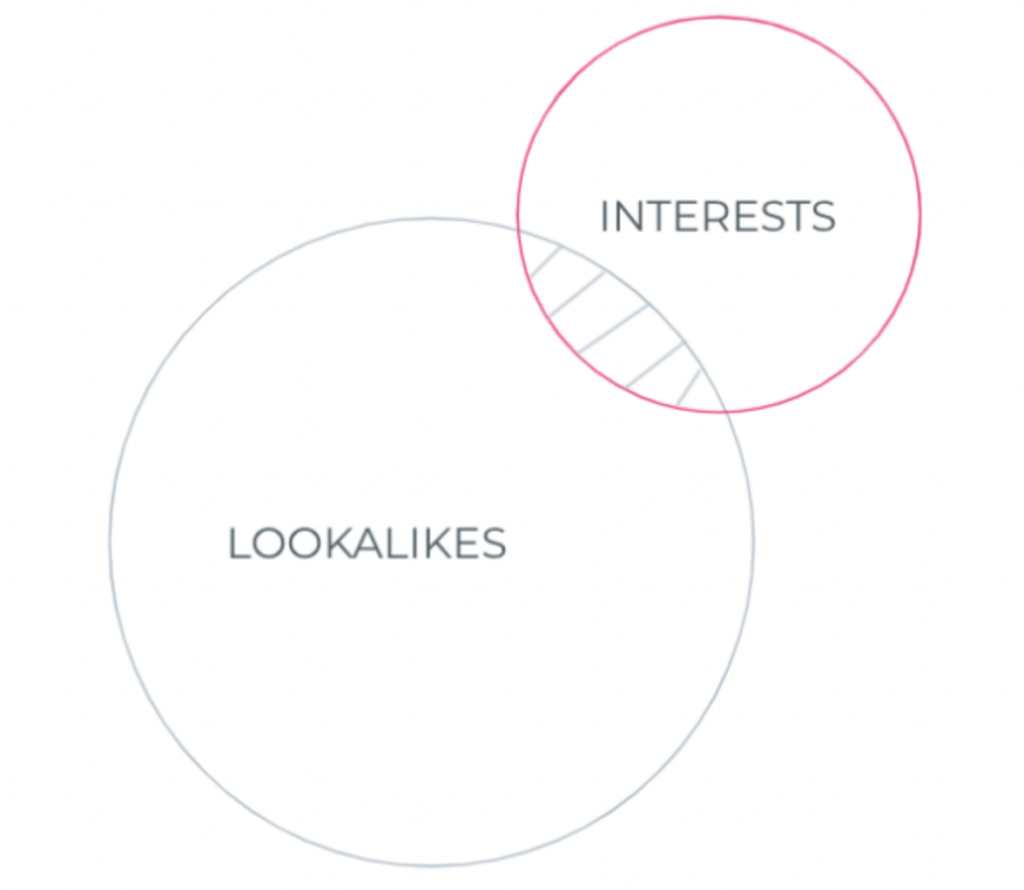
But more importantly, when you stack multiple audiences into one ad set, you won’t be able to properly test all the lookalikes and interests. Meaning, that pinpointing which interest or lookalike has generated most of the conversions is going to be impossible.
Additionally, you could have a great interest stacked with a low-performing one that is then affecting your ad performance and overall results.
In terms of the best targeting strategy, we found that going broad is most beneficial.
Facebook has become good at knowing who will convert, and where – on which placement.
Lookalikes may have been the best performers a couple of years ago, but Facebook is constantly changing and improving, and so should your strategy.
Facebook Ad Mistake 5: Not separating your prospecting and retargeting audiences
- PROSPECTING = Cold audience = Top of the funnel traffic
- RETARGETING = Warm audience = Lower funnel traffic
Why is important to separate these two audiences?
Facebook Ad Mistake 6: Not splitting your budget properly
Now let’s talk about your ad budget. We often see businesses investing too much in their retargeting campaigns and too little in their prospecting campaigns.
We usually like to recommend the 80/20 rule. Meaning, putting around 80% of your budget on prospecting campaigns and 20% on retargeting campaigns.
You may think you’re investing too little for retargeting, but remember, this audience already knows about your brand and you don’t want to have a budget that will get you a higher frequency in just a couple of days.
Plus, it’s extremely important to work on your prospecting campaign so you can later on also retarget those people and improve your retargeting efforts.
Facebook Ad Mistake 7: Not utilizing the whole anatomy of an ad
Another simple, yet common Facebook ad mistake you may make is not utilizing the whole anatomy of an ad.
Every Facebook ad is composed of five different elements:
- primary ad text,
- visual,
- call to action button (CTA),
- headline,
- description.

Some advertisers might choose to not utilize a call to action button (CTA) or to leave the headline and description empty, but we’ve found that by utilizing all the available elements of an ad you’ll get the best results.
Facebook Ad Mistake 8: Using video ads
Even though a lot of advertisers still use videos for their ad creative, we’d highly suggest you avoid them.
We know, we know – videos are way more fun and engaging than static images, but when it comes to the actual results, 90% percent of the time static images outperform videos.
Analyzing an a/b test we ran, we can see that when using static images, results were better across all four metrics.
In some cases, we’ve seen a better CR on video ads, but the CPM was way higher.
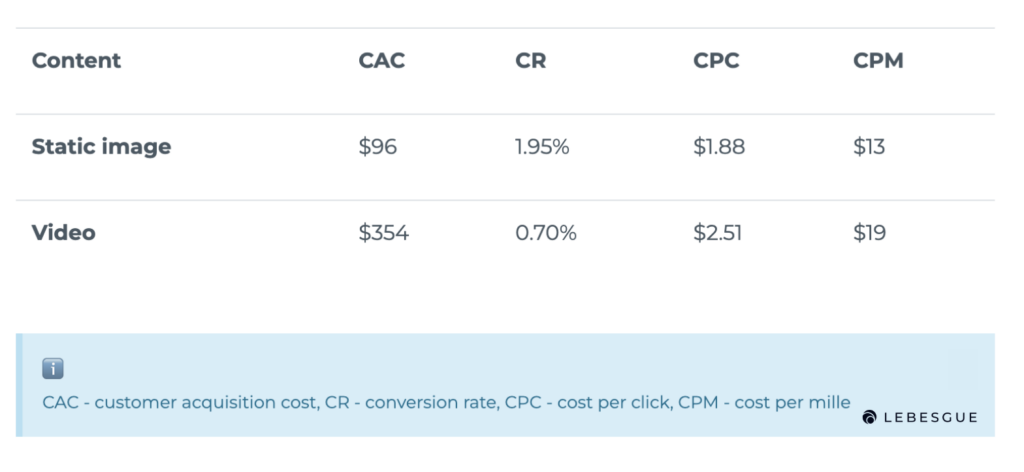
Facebook Ad Mistake 9: Too long ad copy
If your ad has large chunks of text, nobody’s going to notice it or even read it.
Remember, on Facebook, it’s all about grabbing users’ attention as quickly as you can. And apart from a stunning visual, short and engaging ad copy is definitely going to help you achieve that.
In fact, after analyzing 37,259 Facebook ads, AdEspresso found that the ideal length for a headline is 5 words, 14 words for the main text, and 18 words for the description.
As of recently, you may have noticed that Facebook introduced a new feature that has to do with the length of your ad copy.
If your primary text is longer than 280 characters, you’ll receive an alert that suggests shortening the ad copy. We wouldn’t say going above these 280 characters would result in fewer conversions, but it’s worth testing it and letting the performance decide.
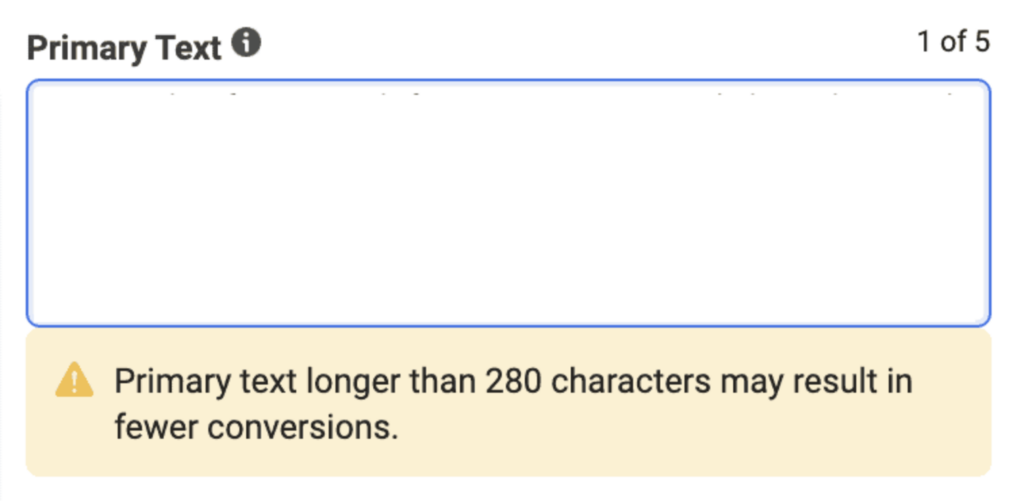
Facebook Ad Mistake 10: Not using emojis
When talking about the ad creative and ad copy, we can’t forget about emojis.
Emojis can make your ad seem more friendly and engaging, and less like you’re trying to sell something. And we all know that the more organic your ad looks, the better.
We decided to test three completely identical ads by just changing the ad description.
The first ad had no description at all, the second one had the five-star emoji (⭐⭐⭐⭐⭐) and the third one mentioned “free shipping”.
Even though the CTR has been mostly the same on all three versions, the CR and ROAS on the ad with the 5-star emojis have been the highest.

So if you’re still not using emojis in your ads, we’d encourage you to test it out.
The easiest way of adding emojis to your ads is through sites like Emojipedia. You can find any emoji you can think of, and simply copy and paste them into your ads.
Also, don’t just add emojis that don’t resonate with your product or ad copy. The purpose is to elevate your ad copy, so if you feel like emojis don’t fit in with your brand, use them a little bit, or don’t use them at all.
Facebook Ad Mistake 11: Using manual placements
Another common Facebook Ad mistake that we often see advertisers make is using manual placements. You might have a fantastic ad setup and creativity, but if you limit your ads to a couple of different placements, chances are that you’re going to lose a lot of potential conversions.
We tested automatic placements vs. manual to see which one would perform best and the results came as no surprise.

When using automatic placements, both the customer acquisition cost and cost per click were significantly lower.
So this just proves that Facebook indeed does a great job at testing all the available placements and pushing the best performers to give you the best possible results.
Facebook Ad Mistake 12: Not using the best performing call to action (CTA) button
At first, you might not think about it, but the CTA you choose also impacts your ad performance. Facebook gives you several CTA options to choose from, but in reality, you should always only choose one.
We see a lot of e-commerce businesses promoting their products, but then using the “Learn More” button. We tested this multiple times on over 400 ad accounts, and “Shop Now” always outperformed any other call to action.
Facebook Ad Mistake 13: Having multiple ads in ad sets
One of the biggest and most common Facebook Ad mistakes we see a lot of advertisers make is having multiple ads in one ad set.
When it comes to setting up your Facebook ads account, we always recommend having a simplified account structure.
Among other things, this means having three to five ad sets per campaign with only one ad per ad set.
The reason why we like to do so is because of a few things.
Say you have four different ads in one ad set, running at the same time, with a daily budget of $50. What can happen is that Facebook will push the delivery of one ad over the others without any obvious reason, and therefore spend most of your budget on that ad.
So what this means is that you’re unable to test all the ads properly and equally. Therefore, we always recommend having one ad per ad set, broken down by creative or audience type.
Facebook Ad Mistake 14: Using the same ad copy & creative
Another common Facebook Ad mistake you can make is to use the same ad copy or creative for your prospecting and retargeting audience.
Your retargeting audience includes people who already visited your website and are familiar with your brand, while your prospecting audience includes people who are not familiar with your brand in any way. Therefore, it’s extremely important to fine-tune and tailor your communication to these two audiences as much as possible.
Since we didn’t exactly know which type of ad copy works best for a certain audience, we decided to analyze over 4000 ads and see which ad copy elements positively or negatively impact the return on ad spend.
So based on our analysis, we can see that prospecting campaigns mentioning free shipping, promotions or the product price positively impact the ROAS.
On the flip side, using any kind of social proof or urgency in your ad copy would not result in such positive results as it negatively impacts the ROAS.
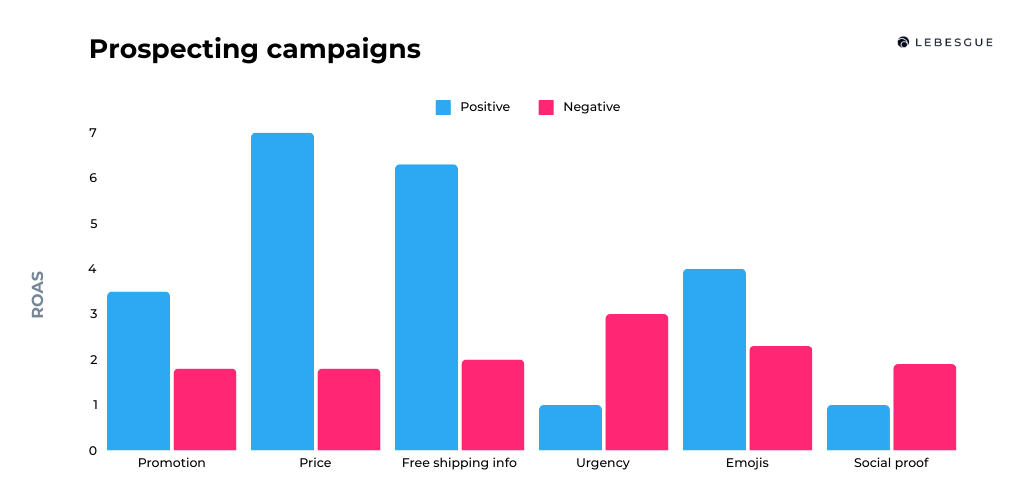
Even though using urgency and social proof doesn’t work for prospecting campaigns we can see quite the opposite for retargeting campaigns.
And when you think of it, it makes total sense. Since your retargeting audience includes people who are familiar with your product or service, naturally, they want to see some testimonials and be reassured about your product.
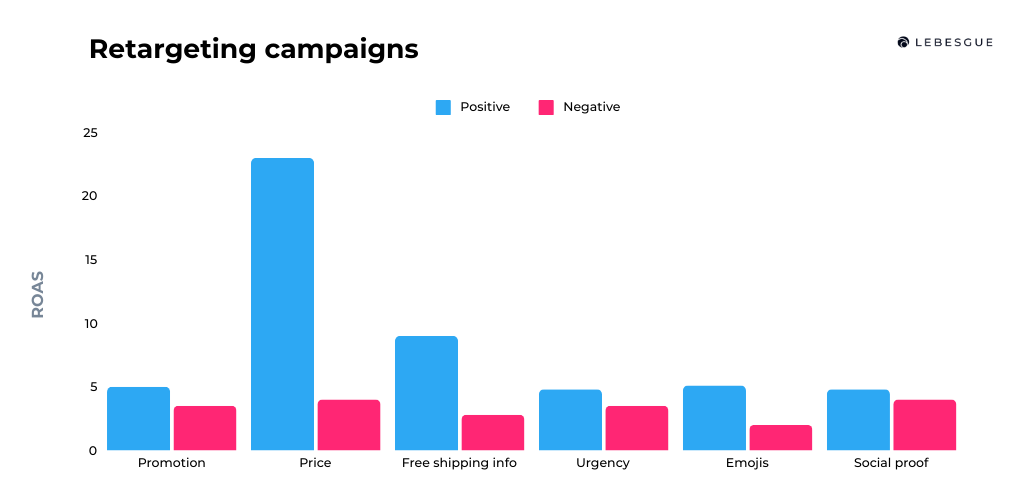
Facebook Ad Mistake 15: Worrying about the learning phase
Ever heard that you have to exit the learning phase to achieve a stable customer acquisition cost and overall, better conversion rate?
Well, we’re here to tell you that you don’t have to.
Even though you’ll find that in the Business Help Center Facebook says that during the learning phase ad sets are less stable and usually have a higher CPA, our results show the exact opposite.
Note: The table below includes aggregated data from multiple ad accounts and ad sets.

As you can see from the results, ad sets that were still in the learning phase had both a lower customer acquisition cost as well as a higher conversion rate. So we can say that the CAC and overall results don’t magically become better once you exit the learning phase.
The bottom line is that you don’t have to worry if your ads are still in the learning phase or in “learning limited”.
Similarly, if you find that you’re ads are not performing well and your CAC is quite high, don’t just assume this is because of the learning phase. It is much more likely that you’re seeing poor results because of a wrong ad account setup.
Facebook Ad Mistake 16: Not using UTM parameters
UTM parameters are a super-easy yet powerful way of understanding the effectiveness of your ads. Using them in your Facebook ads will help further improve your tracking efforts so that you can better understand where your sales are coming from, which ads are generating the most conversions, etc.
You can add UTM parameters on the ad set level, under “Tracking”, right after you input your website URL.
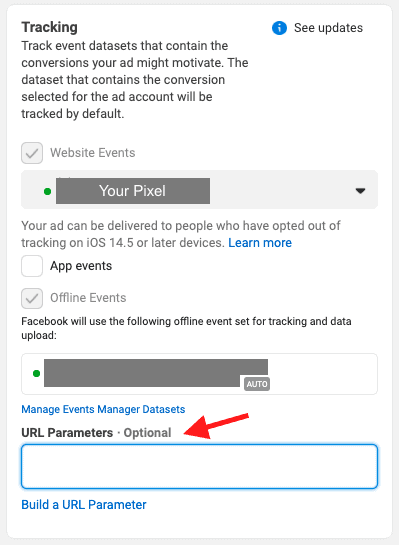
Facebook Ad Mistake 17: Not checking your ad frequency
Monitoring your ad frequency is the key to avoiding ad fatigue — when a target audience sees the same ad too many times.
So essentially, the ad frequency tells you how many times on average a person saw your ad.
A higher ad frequency means that your target audience is seeing the same ad too often, but what is considered a high frequency? How high is too high?
Ideally, you want your frequency to be as low as possible, but we found that sticking with the following two rules will prevent ad fatigue.
- For prospecting ads – a frequency up to 1.5 is ok
- Retargeting – a frequency below or up to 7 is ok
To check your ad frequency, head over to Ads Manager, and under the columns section, click “Delivery”.
Facebook Ad Mistake 18: Using Advantage Budget Optimization
If you’ve been running Facebook Ads for some time, you’re probably familiar with the term Advantage budget optimization and what it means.
For those of you who haven’t noticed it or simply have never heard of it, here’s how Facebook explains it:
Meta Advantage campaign budget optimization (formerly campaign budget optimization) automatically manages your campaign budget across ad sets to get you the overall best results. With CBO, you set one central campaign budget. This budget continuously distributes in real-time to ad sets with the best opportunities, throughout your campaign.
In some cases, Facebook actually recommends you use advantage budget optimization, but here’s why we don’t.
First of all, when using Advantage optimization, you’re not able to manually control budgets at the ad set level. As you saw above, everything is optimized at the campaign level, and therefore, you’re risking allocating your budget to the wrong ad sets.
But as always, we wanted to A/B test this before jumping to any conclusions. We tested it on prospecting and retargeting campaigns, both in the same time period.
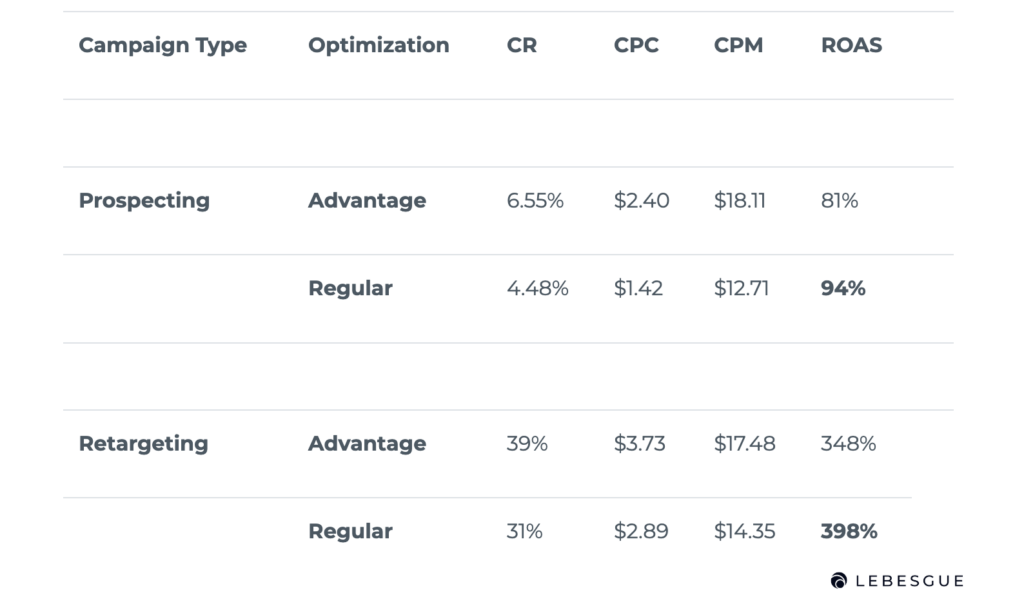
Looking at the results above, we can see that campaigns optimized for CBO had both a higher cost per mille and cost per click.
Even though those campaigns had a slightly higher conversion rate, the return on ad spend was higher on both prospecting and retargeting campaigns that were not using Advantage budget optimization. Therefore, we found that is much better to use regular campaigns and get full control over your ad budget.
Facebook Ad Mistake 19: Not checking your competitors' Facebook ads
Conducting a competitor analysis is extremely important if you want to better understand your competition and how you compare to them.
Especially when it comes to Facebook ads. By analyzing your competitors’ ads you can not only pinpoint what are their strengths or weaknesses but also gain some inspiration to enhance your ad copy, creative, and much more.
And the good news is that you don’t have to spend countless hours on making a full competitive research all by yourself.
We’ve got you covered with our Competitor Intelligence feature – built specifically for e-commerce businesses that want to understand their competition, how they are growing, and what they are doing in terms of Facebook ads.
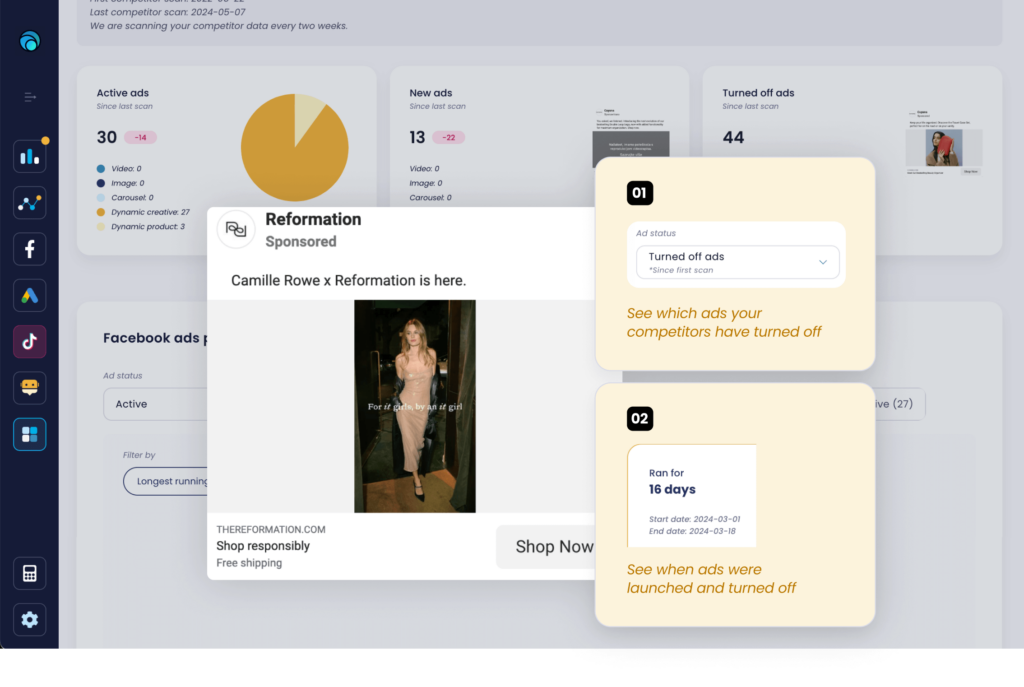
The feature is super intuitive, easy to use and has a lot of great functionalities. Other than being notified when a competitor launch new ads, and being able to analyze their ad copy or creative, you can also analyze their market growth on a monthly, quarterly, and half-yearly period to identify the biggest players on the market.
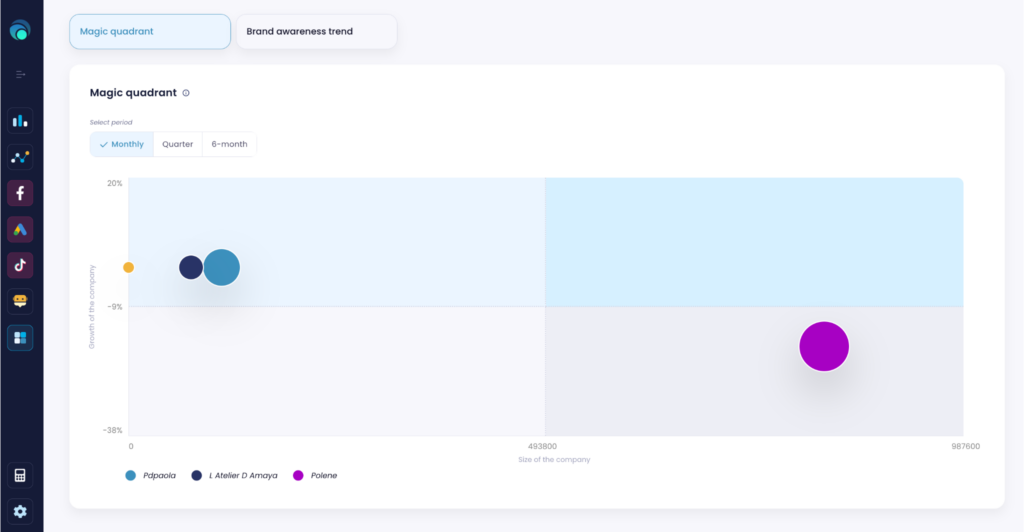
Facebook Ad Mistake 20: Not testing properly and enough
As with any advertising platform, testing enough is essential to understand what’s working best for your business and target audience.
The key thing though is to make sure you’re not testing too many variables at the same time.
You always want to have a separate ad set for each variable that you’re testing. This way you’re truly going to understand what’s working or not.
For example, if you’d want to test out your homepage vs product page as your landing page, the easiest way to test it would be to duplicate the corresponding ad set and only change that one variable that you want to test. In this case that would be the website URL.
Similarly, if you’d like to test multiple ad copies, the wrong thing to do would be to test them by creating multiple ads in one ad set. Instead, you should always follow the rule “1 ad per ad set” so that Facebook can test out all the ads properly.
Facebook Ad Mistake 21: Not using the conversions API
Similar to the Facebook Pixel, the Facebook Conversions API is another tool that helps you more accurately measure and attribute your Facebook ads conversions.
The Conversions API works by collecting and sharing data directly from Shopify’s servers, while the Facebook pixel relies on third-party cookies through web browsers, which may be less reliable because of the iOS 14 changes.
This is not technically considered a Facebook Ad mistake, but by using the Conversions API in addition to the Facebook Pixel, you’re able to maximize the effectiveness of your website events and therefore achieve optimal full-funnel tracking.
Facebook Ad Mistake 22: Not checking if your Facebook pixel is working
After installing the Facebook pixel on your site, you should always check that is working properly. There could be an error in your pixel code base without you even noticing it, resulting in you not tracking conversions properly.
Fortunately, there is a super-easy and fast solution to ensure that this doesn’t happen.
By installing a Chrome extension called Meta Pixel Helper you’ll be able to see a detailed overview of all of your pixels on a specific webpage, including warnings and successes on that pixel.
This way you’ll easily tell if your pixel is firing and working properly.
Facebook Ad Mistake 23: Poorly optimized landing page
You may have a good Facebook ad account setup and creativity, but if your landing page is not optimized properly, you might just lose all those potential customers.
There are several things you should keep an eye on when creating or optimizing your landing page. Such as site speed, call-to-action position, use of testimonials, etc. If you’re interested in learning our top tips and tricks for creating landing pages that convert, check out this post.
How to spot mistakes in your Facebook ad account
If you’re not sure how good or bad your ad account setup is, you can easily check it out in our Lebesuge: AI CMO.
Within our “Advertising Audit” feature we have created multiple tests based on what we think the most important things in terms of ad setup are.
So once you install the app and connect your Facebook ad accounts, you’ll immediately see which tests you’ve passed or failed.
You’ll then see what your overall setup score is and get custom suggestions on how to fix those critical mistakes and improve overall ad performance.
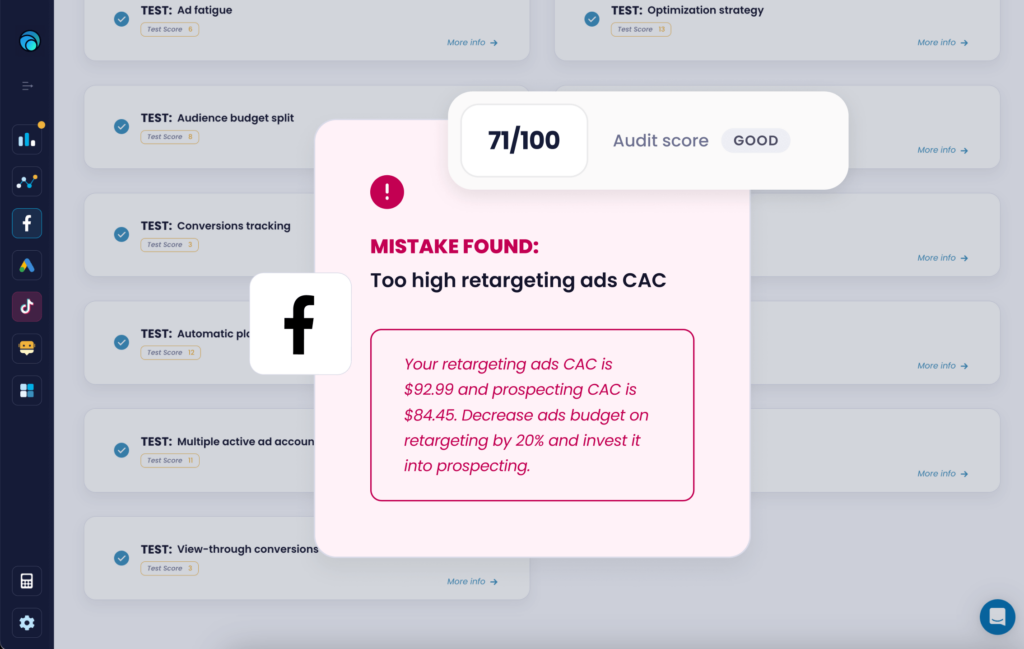
Summing Up
Now that you know what some of the most common Facebook Ad mistakes are and how to avoid them it’s time to start optimizing. Make sure to go through your campaigns to see whether you’re making any of these mistakes.
If you have any questions or need help with your Facebook or Google Ads, feel free to drop us a line at [email protected] or check out our Lebesgue: AI CMO.



